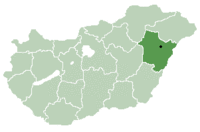University of Debrecen
| Debreceni Egyetem | |
 
|
|
| Latin: Universitas Debreceniensis | |
| Type | Public |
|---|---|
| Established | 1538, 1912 |
| Rector | Prof. Dr. Zoltán Szilvássy |
|
Academic staff
|
1,700 |
| Students | 32,000 |
| Address | Egyetem tér 1, 4010 Debrecen, Debrecen, Hungary |
| Affiliations | EUA |
| Website | www.unideb.hu |
 |
|
The University of Debrecen (Hungarian: Debreceni Egyetem) is a university located in Debrecen, Hungary. It is the oldest continuously operating institution of higher education in Hungary (since 1538). The university has a well established programme in the English language for international students, particularly in the Medical field, which first established education in English in 1986. There are nearly 4000 international students studying at the university. Until 2014 technical Academy Awards (Oscars) have been awarded to five former students.
The university also operates an associated Basic Medicine campus in Geochang County, South Korea.
Higher education began in Debrecen with the Calvinist College of Debrecen, which was founded in 1538. Over centuries of its existence it was one of the key institutions of higher education in Hungary. In the beginning of the 20th century the College was transformed into a university, and has a strong link and cooperation with the present Calvinist College's Debrecen Reformed Theological University.
In 1908, the Calvinist Academy of Humanities was created, and in 1912, the Hungarian Royal University was founded. The university incorporated the theology, law, and arts faculties of the College and added a medical school. Teaching began in 1914 in the old Calvinist College buildings. In 1918, the first new medical school building was opened, and the original medical school campus was completed in 1927.
In 1921, the university took the name of István Tisza, former prime minister of Hungary. In 1932 the university's main building was completed. It is the largest building in the city, and was designed in eclectic and neo-baroque style.
In 1949/1950, the University was restructured under communist control. The primary goal of the "reorganization" was to split the university into smaller, less integrated institutions, and also to weaken or even dissolve units which did not fit to the Soviet agenda of the day. The Faculty of Theology was returned to the Calvinist College, the Faculty of Medicine became an independent university (until 2000), the Faculty of Law was discontinued, and members of the teaching staff were expelled from the University. The departments of English, French, Italian, German, and Classical Philology were closed down, while the Department of Russian expanded dramatically. The teaching of western languages resumed only after 1956, with the exception of Italian which was not offered again until the 1990s.
...
Wikipedia
